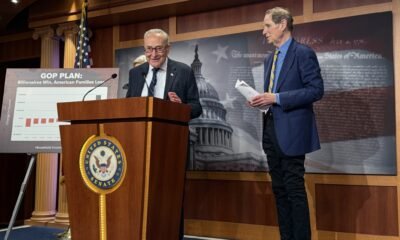cct-tracking
Trump’s High-Stakes Move in Iran: A Test of His ‘No More Stupid Wars’ Promise

In a significant escalation of U.S. involvement in the Middle East, President Donald Trump announced military strikes on Iranian nuclear facilities, claiming they effectively crippled Iran’s nuclear program. The move follows a week of Israeli airstrikes targeting Iran’s military capabilities.
Speaking at the White House, Trump asserted that the U.S. offensive “obliterated” three key enrichment sites, stating that the “bully of the Middle East must now make peace.” However, the action has sparked concerns among lawmakers regarding its constitutional basis and the potential for broader conflict.
Trump emphasized the historical animosity between the U.S. and Iran, noting past attacks linked to Iranian-backed entities, including the 1983 U.S. Embassy bombing in Beirut. “For 40 years, Iran has threatened America and Israel,” he emphasized. “I will not allow this to continue.”
The strikes executed early Sunday marked a surprising shift, as discussions regarding U.S. involvement had intensified but did not indicate immediate action. Reports of U.S. aircraft movements hinted at the possibility of military engagement, which was confirmed shortly thereafter.
Concerns about Trump potentially overstepping his authority emerged quickly. Representatives from both parties criticized the lack of congressional authorization for the strikes. Some lawmakers are advocating for a resolution to prevent further military entanglement without legislative approval.
The military action is a response to both Israel’s recent operations and a long-standing strategy to address Iran’s nuclear capabilities. Reports indicate that the U.S. military deployed advanced munitions, including bunker-buster bombs and Tomahawk missiles, targeting key facilities like Fordo.
Iran’s leadership responded sternly, warning of “irreparable damage” to U.S. interests. Iranian officials have characterized American intervention as potentially leading to an “all-out war” in the region, intensifying the stakes of this conflict.
Despite hopes at the outset of his presidency for a diplomatic resolution, Trump’s approach pivoted to military engagement following pressure from Israeli officials and Republican constituents. Although U.S. intelligence had previously indicated Iran was not actively pursuing a nuclear weapon, Trump dismissed these findings, asserting the need for decisive action.
As the situation develops, Trump’s strategy raises questions about the effectiveness of diplomatic efforts versus military action, especially given that prior negotiations aimed at curbing Iran’s nuclear ambitions only yielded limited results. With heightened military presence in the region, the dynamics continue to evolve, suggesting further volatility ahead.
This content is not an advertisement.


















